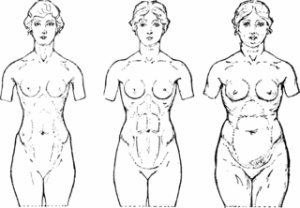‘fit’ or ‘soft’: how the new ‘beautiful’ is still damaging to women
Behold, Lipsters, a new study pronouncing which body shapes are in and which are out has been published online. The survey conducted by online women’s mag SoFeminine found ‘fit’ and ‘soft’ looks are coming into fashion in the UK, despite fashion itself most often ignoring these bodies.
To give you visuals, the Daily Mail describes reality TV star Lucy Mecklenburgh as the ‘fit’ figure favoured by 20% of women. I didn’t have any idea who she is, so you probably don’t either: let’s just say she’s every Ashy Bines Bikini Body Challenge ‘after’ shot that’s appeared in your Facebook newsfeed whether through friends or your own liking. Mad Men star Christina Hendricks is the epitome of a soft, curvier frame which is admired by a massive 68% of women surveyed.
Women are saying goodbye to the silicone lumps and bumps of Pamela Anderson and friends as women now see the look as ‘overhyped, oversexed and demeaning’. Apparently supermodel-grade thinness is on the outer as well at 7% desirability, though it is still more popular than aforementioned ‘porn star’ looks and women considered ‘plus-size’.
Despite the massive popularity of the ‘soft’ body, it is still a small number of women (3%) still finding fuller figures (or, to use a term I don’t like to use, ‘plus size’) attractive, putting it into perspective that the curviness of a soft body does not necessarily equal more than maybe a size 12-14. However, compared to the last SoFeminine survey, the percentage has doubled.
Amongst all these figures about figures which can’t necessarily be equated to a significantly accurate picture of what women want, there’s a number that sticks out like a sore thumb. Regardless of the SoFeminine survey’s credibility, 92% of respondents said they were still under pressure to conform to the ideas of the body beautiful du jour. This is in spite of them finding the soft body an attainable figure and supposedly celebrating the ability to cancel their gym membership.
Instead of radical surgery or dieting to achieve porn star or thin bodies, looks traditionally associated with health (i.e. musculature and / or curviness = fertility) are being touted as number one. This still has ramifications for women: thin women, women who don’t have an ample bust, butt or hip measurement, and of course anybody who can’t build up muscle when aspiring to fitness.
I have beautiful friends who may be called ‘thin’ who find it difficult to put on weight regardless of what they eat. With thin supposedly on its way out, the comments regarding my slighter sisters’ health (or lack thereof) are bound to become more. I also have gorgeous friends who don’t look like their body has formed naturally to the shape of a corset, either. It is ridiculously hard to achieve a traditional hourglass figure (i.e. the bust and hips being at least nine inches larger than the waist) à la Christina Hendricks when your body doesn’t store fat that way. You can’t change your genetics, and on that note converting fat women have into muscle isn’t going to be a walk in the park if your body doesn’t want to do it… particularly considering women’s bodies are theoretically made to store it.
Categorising bodies – people – as ‘wonderful’ without observing the words and actions coming from it is always en vogue despite the awful anxieties it produces. Take it from somebody whose body has gone from (what could be loosely defined as) ‘plus size’ to ‘fit’ to ‘plus size’ to something that isn’t quite any of these labels: even if you get what you want, there’s no guarantee you’ll be 100% satisfied unless you accept yourself.
For all these reasons, if women don’t conform to ‘fit’ or ‘soft’ body types it is conceivable that diets and surgery may still take a horrendous toll on women, regardless of what SoFeminine decrees. It is a problem to idealise the shapes and forms of others without learning to love what you have.



Great article. It also annoys me that when these studies say “soft” they mean a very particular shape – the hourglass, as you’ve outlined, is usually chosen as the example. And “fit” bodies are those muscular ones without an ounce of fat, not just an all-encompassing inclusion of anyone who is actually healthy (we all know people who run marathons or do heaps of sport whose bodies don’t fit that “fitspo” ideal). The whole thing is so infuriating because it’s still judging women by their bodies, not their intellect or skills or opinions – are there ever surveys of men saying “which body type is your ideal, Jonah Hill or Alexander Skarsgaard?” Gah.